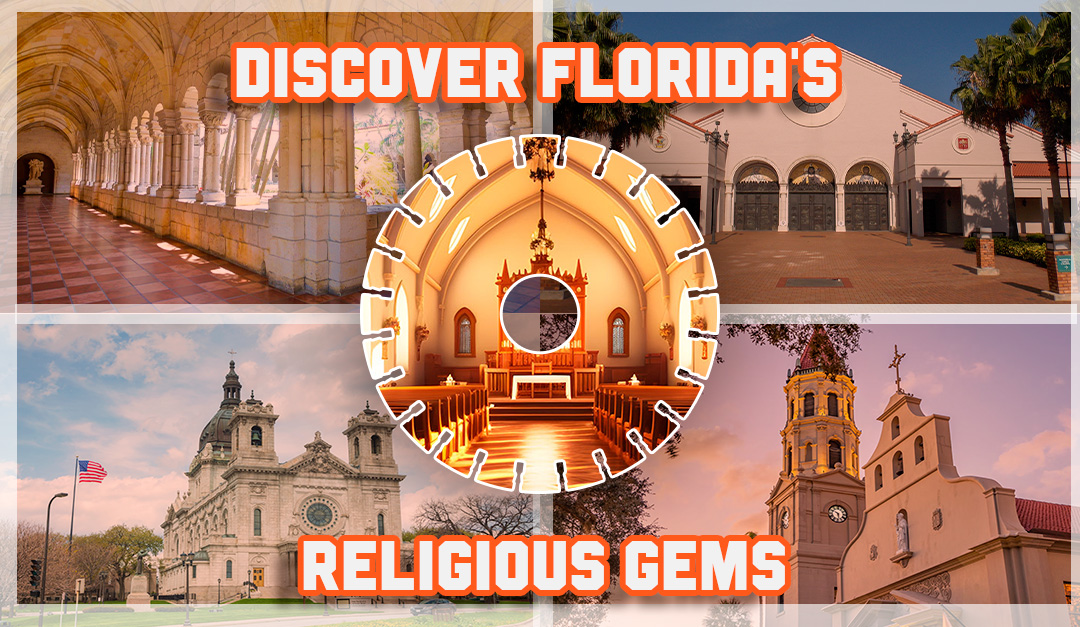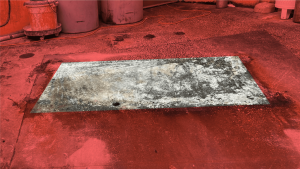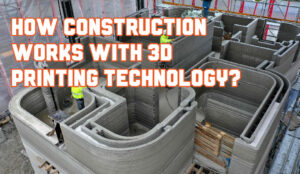Historical Context
Florida’s Religious Gems. Florida is not just about beaches and sun, it is also about history and faith! Since thearrival of the Spanish in the 16th century, religion has left its mark withchurches thatstill tell incredible stories today. The Cathedral Basilica of St. Augustine, in the oldestcity in the US, is a treasure that combines art and spirituality.
Over time, British, American and immigrants from all over the world arrived,bringing diversity and creating unique temples such as the Sanctuary of Our Lady ofCharity in Miami, an emblem for the Cuban community. Each religious building inFlorida is much more than a place of worship: it is a bridge to the past full of art,culture and tradition.
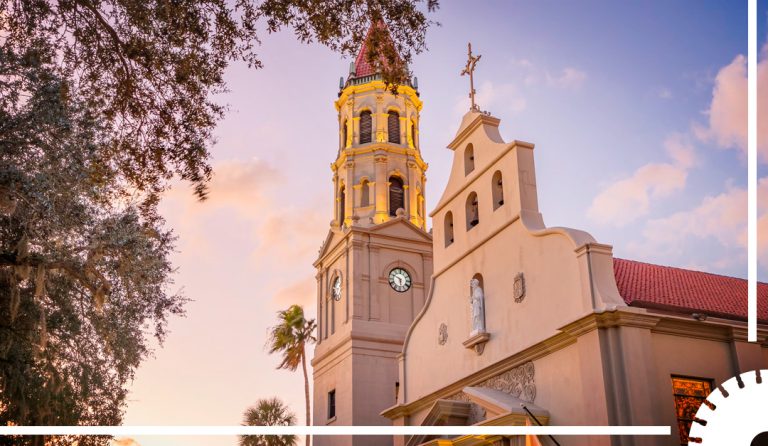
Most Common Church Architectural Styles
Florida churches reflect a rich architectural diversity, with each style not only adding beauty but also symbolizing faith and spiritual connection. Predominant styles include:
- Spanish Renaissance: This style is characterized by high ceilings, rounded arches, and elaborate ornamental details. The expansive structure represents the grandeur of God and seeks to create a sense of spiritual elevation. Churches such as the Cathedral Basilica of St. Augustine are a perfect example, with its architecture symbolizing the cross and divine order.
- Neogothic: With its pointed towers and stained glass windows that filter light in beautiful patterns, the Gothic Revival style aims to bring the faithful closer to God through verticality, drawing the eye upward, symbolizing the soul’s longing for heaven. A clear example of this style is the Basilica of the Immaculate Conception in Jacksonville.
- Baroque: The opulence of the Baroque is meant to impress and amaze the viewer, reflecting the magnificence of divinity. The curved shapes and elaborate ornaments represent the exuberance of divine creation, especially in the churches built by the missions.
- Modernism: This style seeks to simplify forms without losing their spiritual meaning. The use of clean lines and open spaces in churches such as the Basilica of the National Shrine of Mary, Queen of the Universe seeks to connect the spiritual with everyday life, providing an accessible, functional and light-filled space.
Each of these styles not only beautifies, but also visually communicates deep religious values, creating an environment where worshipers can experience transcendence.
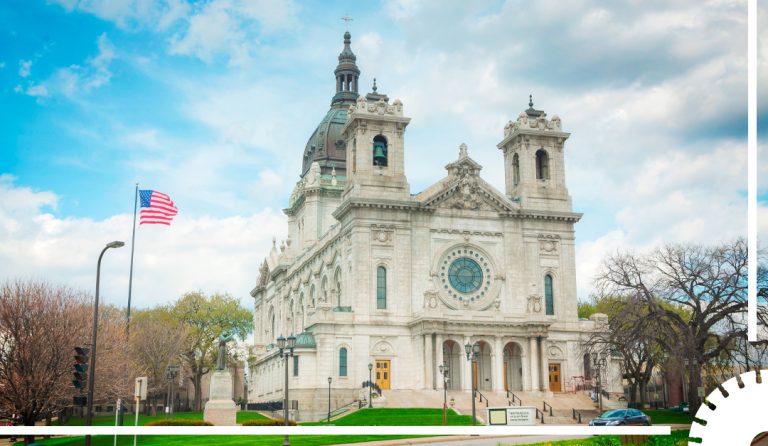
Featured Churches in Central Florida or Orlando
Churches in Central Florida, especially in Orlando, are not only places of worship, but also examples of how religious architecture reflects the spirit of local communities. Some of the most notable include:
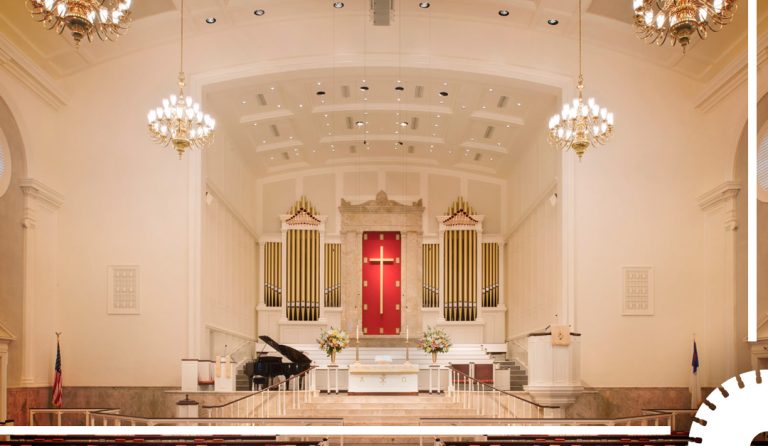
- Basilica of the National Shrine of Mary, Queen of the Universe: Its modern architecture is not only functional, but also symbolic. Clean geometric shapes and the use of natural light are designed to create a sense of openness, inviting worshippers to unite with God in a direct and personal way.
- First United Methodist Church of Orlando: This neo-Gothic temple features high ceilings, pointed arches, and detailed stained glass windows. These features are meant to symbolize the connection with the divine, elevating the gaze toward the heavens and providing an environment of deep meditation.
- St. James CathedralThis cathedral mixes elements of neoclassical style with modern details. Its columns and portals are symbols of strength and the continuous presence of God in the lives of the faithful.
- Holy Family Catholic Church: Its contemporary design and simple forms reflect the modern philosophy of religious architecture: functionality, accessibility and an atmosphere that invites personal reflection.
- St. Luke’s United Methodist Church: This church, in contemporary architectural style, is distinguished by its functional and open design. Clean lines and the use of modern materials, such as glass, allow natural light to flow throughout the space, creating an atmosphere of peace and reflection. Its structure reflects the church’s mission to be inclusive and accessible to the community, with a focus on personal connection to spirituality.
Each of these churches uses its architectural design to foster a sense of community and spiritual connection, while reinforcing the importance of faith in daily life.
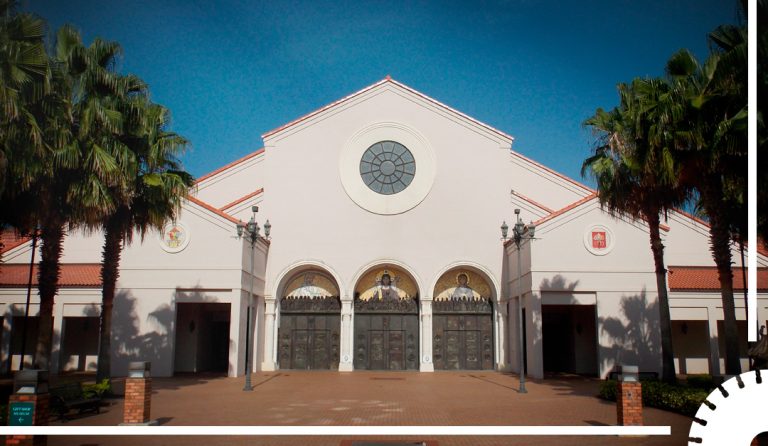
Curiosities and cultural data based on the architecture of churches
Florida church architecture is filled with details that are not only aesthetically stunning, but are also loaded with symbolism and meaning. Architectural elements such as arches, columns, and structural forms serve both an aesthetic and spiritual function. These details blend with architectural styles to create a unique atmosphere that reflects the history and beliefs of each community. Here are some interesting facts and trivia about how these elements fit into Florida church architecture:
- The power of bows: Arches are a fundamental element in many Florida churches, especially in Gothic and Renaissance styles. In Neo-Gothic, pointed arches not only serve to support the structure, but also symbolize spiritual elevation, guiding the eye toward heaven. This vertical connection reflects the soul’s aspiration toward the divine. Additionally, arches allow for higher ceilings, creating a sense of grandeur and spirituality.
- Columns as symbols of strength: Columns in classical style churches, such as those at First United Methodist Church in Orlando, are not only structural elements, but also symbolize the stability and firmness of faith. Doric or Corinthian columns, popular in the neoclassical style, represent the solidity and durability of the church in the lives of the faithful, while the more ornate columns of the baroque style suggest the exuberance of divine love.
- The symbolism of geometric shapes: The cross shape, visible in the design of many churches, has a strong symbolic component. For example, in the Basilica of the National Shrine of Mary, Queen of the Universe, the cross-shaped plan is directly related to Christ’s sacrifice. Geometric shapes, such as circles and squares, are also present in modern churches, symbolizing divine perfection and the connection between heaven and earth.
- Fusion of styles: Many churches in Florida display a fusion of architectural styles that not only represents an aesthetic blend, but also a cultural one. A notable example is the St. James Cathedral in Orlando, which combines elements of neoclassical architecture with Romanesque details. This fusion symbolizes the union of different Christian traditions, reflecting the diversity of the local population. The rounded arches and Roman columns bring stability and connection to Christian history, while the neoclassical details bring an air of modernity and accessibility.
- The use of natural light: In many contemporary churches, such as the Basilica of the National Shrine of Mary, Queen of the Universe, the design of the windows and the use of stained glass is not just decorative. The light that enters through the stained glass symbolizes the divine light that guides believers. This relationship between the architectural structure and natural light reflects the idea that the church is not only a physical space, but also a place of revelation and spiritual transcendence.
These architectural elements, from arches to columns, have been integrated into the design of Florida churches to create a unique environment for worship and reflection. Each detail has a purpose beyond simple aesthetics, serving as a vehicle for the communication of faith and spirituality. The fusion of different architectural styles also reveals how religious architecture evolves, adapting to new cultural currents without losing its central purpose: connecting the faithful with the divine.
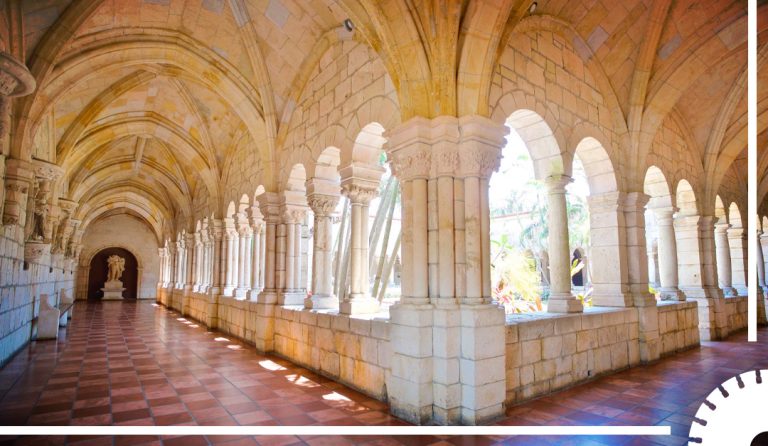
Conclusion focused on architecture
The architecture of churches in Florida is a tangible reflection of our values: respect for tradition, the search for transcendence and the ability to adapt to modernity. These structures show us that the ancient and the contemporary are not in conflict, but can coexist harmoniously. From the Gothic arches that evoke a celestial connection to the modern lines that promote accessibility and light, these buildings inspire both faithful and design lovers.
In this balance between tradition and modernity we find practical and aesthetically attractive solutions that not only honor the past, but also project into the future. This is something Helder’s Concrete Cutting Company can make a reality for its clients: uniting the richness of architectural heritage with today’s demands for functionality and aesthetics. Whether preserving a legacy, reinterpreting a style or designing something completely new, we work to create spaces that reflect your values and aspirations.
In the end, architecture is not just an art of building, but a way of telling stories. And with our experience, we’re here to help make your vision a reality.
Reference:
- Visit Orlando. “Discover the Churches of Orlando.”Visit Orlando.
- Diocese of Orlando. “Catholic Churches in Central Florida.”Orlando Diocese.
- National Park Service. “Architecture of Florida’s Religious Heritage.”NPS.
- Visit Florida. “Discover Florida’s Historic Churches.”Visit Florida.
- Visit Florida. “Florida’s Religious Heritage.”Visit Florida.
- National Park Service. “Florida’s Religious History.”NPS.
- Visit Florida. “Hidden Gems: Florida Churches.”Visit Florida.
Need help with a project? Contact us.

